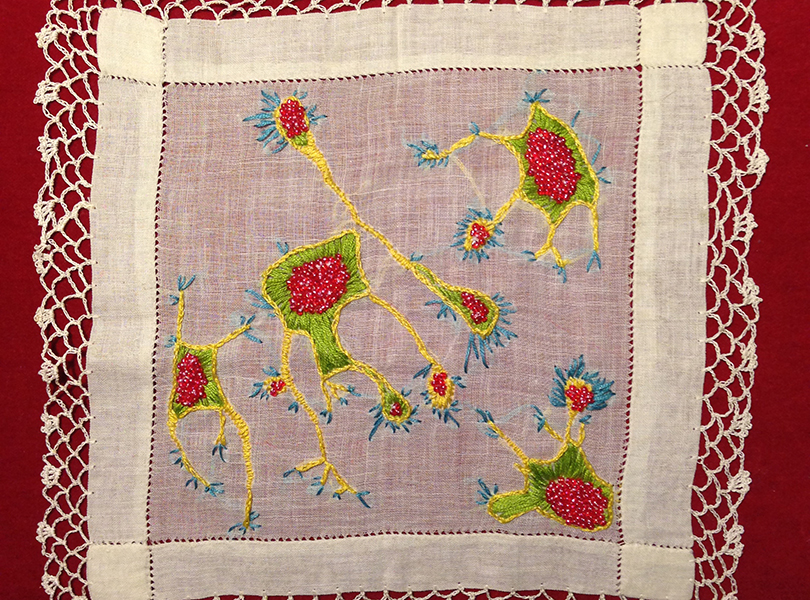
I was cleaning out my (still) cluttered closet the other day when I came upon an old metal box. Unsure of what was inside, I excitedly opened it to find a stack of neatly packed doilies and handkerchiefs. Mind you, these aren't just any old doilies and handkerchiefs. They make up a body of work I did for my undergraduate Textile Design thesis. Each one was tediously encrusted with hundreds of tiny glass beads and patiently embroidered with thin silk thread.
For the better part of a year my life was consumed with embellishing old scraps of fabric with microscopic images of bacteria, viruses, and diatoms. I'm not sure what exactly compelled me to do this, but once I started it became a bit of an obsession. Something about the seemingly endless variety of shapes and colors in these images from high-powered microscopes absolutely beguiled my imagination. Furthermore, the idea that something so menacing, malignant, and terrible could appear so beautiful at the cellular level was just perverse enough to illicit some interesting reactions. I recall one woman at my thesis show who called her friend over to look at a piece which represented Salmonella. They both leaned way in muttering "Oh how gorgeous!" but physically recoiled once they realized what it was depicting.
While sifting through all this old work I came upon one piece in particular which struck a new chord with me-a brain synapse done up in magenta, teal, and lime green on a delicate square handkerchief. Our Federal Way High School design team had been trying to come up with a way to describe the connectivity of the interior spaces and this was the answer! And so the synapse found its way from that old project to a new one.
In biology, a synapse is a place where one signal passes from one nerve cell to another. For the new Federal Way High School, however, a synapse is a place where a signal passes from one student to another.
Conceived as a collection of programmatic blocks linked by a generous commons area and circulation, FWHS promises to be exciting for the individual and group alike. Spaces of varying scales provide opportunities for structured, impromptu, individual, and group interactions. This variety is significant, as Alvar Aalto pointed out: "...the small units and details a person is engaged in form a kind of framework, a system of cells, which eventually turns into the entity of the building".
In the same vein that Aalto referenced the cellular connections in the human body, the metaphor of a synapse (from the Greek synhaptein, to fasten together) suggests the design intent behind multiple student-owned "Third Places" throughout the new high school. Neither home nor workplace, they are open to suggestion and ever-changing possibilities.
According to Juhani Pallsmaa, "Architecture is usually understood as visual syntax, but can also be conceived through a sequence of human situations and encounters". These Third Places provide linkages between just such sequences. Hotspots for communicating, sharing, socializing, learning, teaching, and exploring, they are active hubs that not only serve as billboards for each classroom block but also provide students with spaces they can control.
But HOW? By providing modular furniture? Embracing a graffiti-esque approach by slathering everything in whiteboard paint? Projecting Twitter feeds and Instagram photos on the walls?
In a program that puts such weight on future adaptability, we must be cognizant of securing these student spaces so that in years to come, no matter the classroom configuration, the experience is still greater than the sum of its parts.

